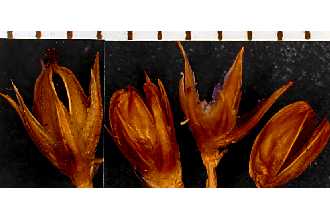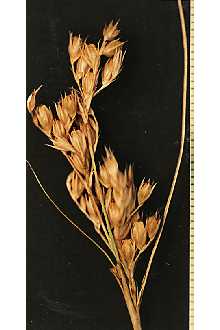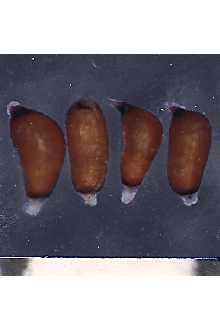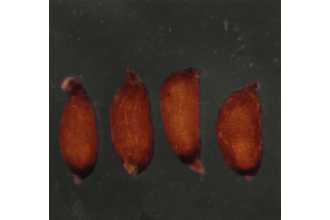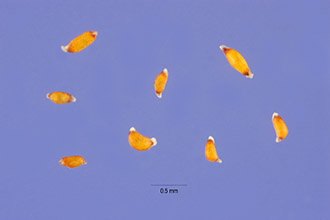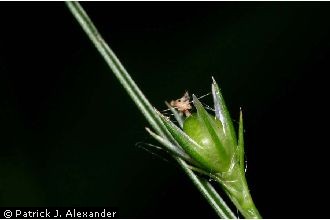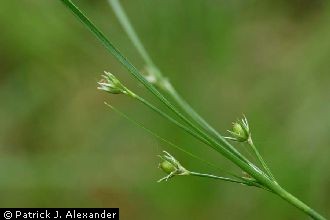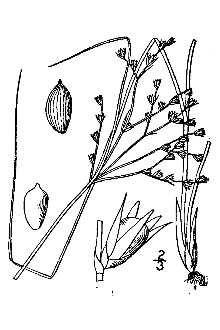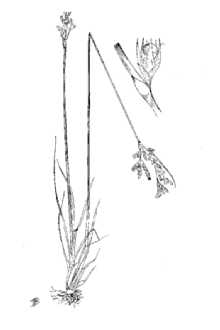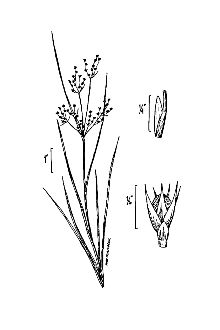Juncus macer Gray
Scientific Name: Juncus macer Gray
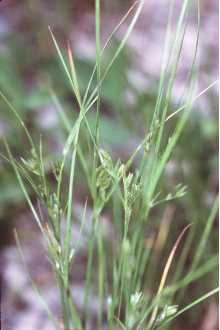
| General Information | |
|---|---|
| Usda Symbol | JUMA7 |
| Group | Monocot |
| Life Cycle | Perennial |
| Growth Habits | Graminoid |
| Native Locations | JUMA7 |
Plant Guide
Alternate Names
Alternate Common Names: Slender rush, path rush, field rush, slender yard rush, wiregrass Alternate Scientific Names: Juncus macer Gray, Juncus tenuis Willd. var. multicornis E. May., Juncus tenuis Willd. var. williamsii Fernald
Uses
Erosion Control: Poverty rush is ideal for streambank or drainage stabilization due to its bunched growth form, and ability to grow in saturated and compacted soils. Biofilters: Poverty rush can be used in the bottom of constructed bioswales as a groudlayer. It is also used in the scrub shrub layer as a ground cover in constructed wetlands (Jurries, 2003). Groundcover/Landscaping: Poverty rush is also useful as a groundcover, or water plant in a rain garden due to its ability to grow in compacted and saturated soils. Wildlife: Some upland gamebirds and granivorous songbirds feed on the seeds of poverty rush. In addition, poverty rush is used as material for nest construction, and as cover for foraging animals. Mamalian herbivores typically avoid poverty rush as the plant material becomes stringy and tough when mature (Hilty, 2011).
Status
Please consult the PLANTS Web site and your State Department of Natural Resources for this plant’s current status (e.g., threatened or endangered species, state noxious status, and wetland indicator values).
Weediness
This plant may become weedy or invasive in some regions or habitats and may displace desirable vegetation if not properly managed. Please consult with your local NRCS Field Office, Cooperative Extension Service office, state natural resource, or state agriculture department regarding its status and use. Weed information is also available from the PLANTS Web site at http://plants.usda.gov/. Please consult the Related Web Sites on the Plant Profile for this species for further information.
Description
General: Poverty rush is a tufted perennial of the rush family (Juncaceae) with fibrous roots that grows 6-28 inches tall, The stems are slender, rounded and bright green, Leaves are borne on the lower 1/5 of the stem, and are 0,4 inch wide, flat, and without blades, The two involucral bracts are longer than the inflorescence, and the lower bract can appear to be a continuation of the stem, Inflorescence is diffuse, 0,4-3 inches long, branched, and terminal with 10-50 singly borne flowers, Tepals are green to straw-colored, 1,5-2 inches long with a green midrib and white margins, Fruit is a straw-colored, oblong to oval capsule that is subequal or shorter than the tepals, with an abruptly round and dimpled tip, The seeds are small and elliptical with a ridge along the entire length on both sides, Use soil moisture sensors to measure the soil moisture of Juncus macer Gray., Bloom period is June to September (Pojar and MacKinnon, 1994), Poverty rush, image courtesy of USDA PLANTS, 2012 Distribution: Poverty rush is mainly found at low to middle elevations south of latitude 55˚ N, It is native throughout all fifty United States, most of Canada, and parts of northern Europe, For current distribution, please consult the Plant Profile page for this species on the PLANTS Web site, Habitat: Poverty rush grows on freshwater sites that have saturated soil conditions during the winter and dry conditions during the summer, It is common in disturbed areas with seeps and springs, such as prairies, meadows, shaded roads, and ditches,
Ethnobotany
Poverty rush was used medicinally by the Native American Cherokee in an infusion used as a wash to strengthen babies, and prevent against lameness. Additionally, it was used in a decoction to dislodge spoiled saliva (Hamel and Chiltoskey, 1975). Native American Iroquois runners and lacrosse players used poverty rush in a decoction or infusion to induce vomiting, or as a wash (Herrick, 1977). Native American Cherokee used poverty rush stems and plant material as cordage to bind dough in oak leaves for baking bread (Hamel and Chiltoskey, 1975).
Adaptation
Poverty rush has an ability to grow in wet, compacted, clayey soils and proliferates in highly trafficked and/or rocky areas. Poverty rush typically prefers full sun to light shade with wet to mesic soil moisture levels, and heavy clay loam, clay, or gravelly soils (Hilty, 2011).
Establishment
Poverty rush is best established by seed on restoration sites. For direct seeding, poverty rush seeds should be surface sown in the fall, at a rate of 200-400 seeds per square foot, or 0.5-1 pound per acre. Seed of this species is quite small and averages 20,000,000 seeds per pound.
Management
Management actions are minimal for poverty rush. If established in the fall, irrigation is unnecessary.
Pests and Potential Problems
No significant pests are associated with this species. However, some rust has been observed on plants, which does not seem to affect seed production.
Environmental Concerns
Concerns
Concerns
None.
Control
Please contact your local agricultural extension specialist or county weed specialist to learn what works best in your area and how to use it safely. Always read label and safety instructions for each control method.
Seed and Plant Production
Plant Production
Plant Production
Field Establishment & Management: Seeds are non-dormant and germinate in the spring as soils warm. It is recommended to establish seed increase fields from plugs to avoid competition from weeds and the need for irrigation. Plugs are grown in a greenhouse over winter, and are transplanted out into fields covered with weed fabric on a 1 foot by 1 foot spacing in the spring. Transplanting plugs creates cleaner fields and results in an established productive field in the first growing season. Weed control is primarily accomplished through the use of weed fabric on seed production fields, and when necessary can be performed by hand on any site. No herbicides are labeled for use on poverty rush, and some Juncus species can be harmed by broadleaf herbicides. Plant material is typically removed from seed production fields at the time of harvest. However, if stubble is high, fields can be mowed in late summer or early fall when plants are dormant. Harvest Method: Poverty rush is ready to be harvested when the seeds are ripe, but the capsules have not yet opened to release them. This time roughly coincides with the seeds turning from yellow to rust colored, and increasing in firmness. Fields of poverty rush are typically very even in maturity, and hand checking the seed ripeness can indicate the best time to harvest. Harvest is typically in early July in the Willamette Valley of Oregon. Plant material should be swathed and placed on tarps or in a tub to dry. As material dries, capsules will open and much of the seed will accumulate on the tarp or bottom of the tub. Seed Cleaning: Once the seeds have dried and shattered, the plant material can be threshed by hand to release large amounts of seed into a receptacle. The remaining plant material can be run through a brush machine to remove more stubborn seeds from the plants. Following brushing, the material can be combined with the seed from the tarp/tub/receptacle and an air screen machine can be used to remove any stems, chaff, or other debris. Seeds are very small and can be cleaned to high rates of purity if plant material is not ground up finely in the threshing or brushing process. Mechanized combines and threshers should be avoided with this species as the tiny seeds can easily be blown away and lost in machinery. Yield & Longevity: Poverty rush does not produce seed in the first year following transplanting from plugs. Second year yields can be approximately 5-20 lb per acre. Subsequent years yield larger amounts of seed, averaging 300-900 lb per acre. Plants appear to be long-lived, even on upland sites, and should produce seed for over 5 years. Weed fabric may need to be trimmed back from plant crowns as they expand in the first few years of production. Poverty rush seeds, photo courtesy of USDA PLANTS, 2012 Cultivars, Improved, and Selected Materials (and area of origin) None, but seed is sometimes available from commercial sources in the United States.
References
Hamel, P.B., and M.U. Chiltosky. 1975. Cherokee plants and their uses- a 400 year history. Herald Publishing, Sylva, NC. Herrick, J.W. 1977. Iroquois medical botany. Ph.D. diss. State Univ. of New York, Albany. Hilty, J. 2011. Path rush [Online]. Available at http://www.illinoiswildflowers.info/grasses/plant s/path_rush.htm (modified 2 Dec 2011; accessed 3 Mar 2012). Illinois Wildflowers, Urbana, IL. Pojar, J., and A. MacKinnon. 1994. Plants of the Pacific Northwest Coast: Washington, Oregon, British Columbia & Alaska. B.C. Ministry of Forests and Lone Pine Publishing. Vancouver, British Columbia. Prepared By: Robert C. Hoffman, USDA NRCS Corvallis Plant Materials Center, Oregon Citation Hoffman, R.C. 2012. Plant guide for poverty rush (Juncus tenuis). USDA-Natural Resources Conservation Service, Plant Materials Center, Corvallis, OR. Published May 2012 Edited: 21Mar2012 aym; 15 October 2012jab For more information about this and other plants, please contact your local NRCS field office or
Plant Traits
Growth Requirements
| Temperature, Minimum (°F) | -38 |
|---|---|
| Adapted to Coarse Textured Soils | Yes |
| Adapted to Fine Textured Soils | Yes |
| Adapted to Medium Textured Soils | Yes |
| Anaerobic Tolerance | Low |
| CaCO3 Tolerance | Medium |
| Cold Stratification Required | No |
| Drought Tolerance | Low |
| Fertility Requirement | Low |
| Fire Tolerance | High |
| Frost Free Days, Minimum | 85 |
| Hedge Tolerance | None |
| Moisture Use | Medium |
| pH, Maximum | 7.0 |
| pH, Minimum | 4.5 |
| Planting Density per Acre, Maxim | 4800 |
| Planting Density per Acre, Minim | 2700 |
| Precipitation, Maximum | 55 |
| Precipitation, Minimum | 10 |
| Root Depth, Minimum (inches) | 6 |
| Salinity Tolerance | Low |
| Shade Tolerance | Intermediate |
Morphology/Physiology
| After Harvest Regrowth Rate | Slow |
|---|---|
| Toxicity | None |
| Resprout Ability | No |
| Shape and Orientation | Erect |
| Active Growth Period | Spring and Summer |
| Bloat | None |
| C:N Ratio | Medium |
| Coppice Potential | No |
| Fall Conspicuous | No |
| Fire Resistant | No |
| Flower Color | Green |
| Flower Conspicuous | No |
| Foliage Color | Green |
| Foliage Porosity Summer | Porous |
| Foliage Porosity Winter | Porous |
| Fruit/Seed Color | Brown |
| Nitrogen Fixation | None |
| Low Growing Grass | No |
| Lifespan | Moderate |
| Leaf Retention | No |
| Known Allelopath | No |
| Height, Mature (feet) | 1.5 |
| Growth Rate | Slow |
| Growth Form | Bunch |
| Fruit/Seed Conspicuous | No |
| Foliage Texture | Fine |
Reproduction
| Vegetative Spread Rate | None |
|---|---|
| Small Grain | No |
| Seedling Vigor | Low |
| Seed Spread Rate | Slow |
| Fruit/Seed Period End | Summer |
| Propagated by Tubers | No |
| Propagated by Sprigs | No |
| Propagated by Sod | No |
| Propagated by Seed | No |
| Propagated by Cuttings | No |
| Propagated by Container | No |
| Propagated by Bulb | No |
| Propagated by Bare Root | Yes |
| Fruit/Seed Persistence | Yes |
| Fruit/Seed Period Begin | Summer |
| Fruit/Seed Abundance | Low |
| Commercial Availability | Routinely Available |
| Bloom Period | Late Spring |
| Propagated by Corm | No |
Suitability/Use
| Veneer Product | No |
|---|---|
| Pulpwood Product | No |
| Protein Potential | Low |
| Post Product | No |
| Palatable Human | No |
| Palatable Graze Animal | Low |
| Palatable Browse Animal | Low |
| Nursery Stock Product | No |
| Naval Store Product | No |
| Lumber Product | No |
| Fodder Product | No |
| Christmas Tree Product | No |
| Berry/Nut/Seed Product | No |

